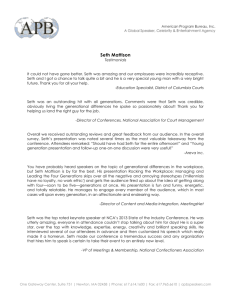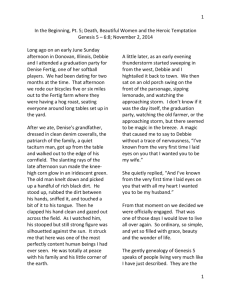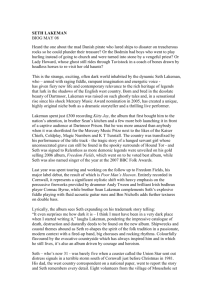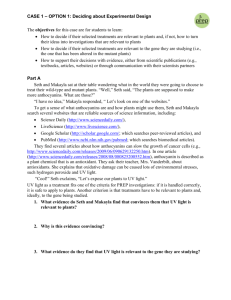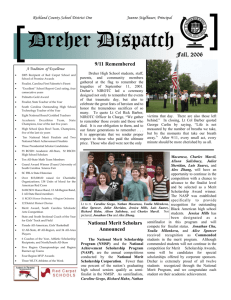Johnson Planning Commission Meeting Minutes, Tuesday, March
advertisement
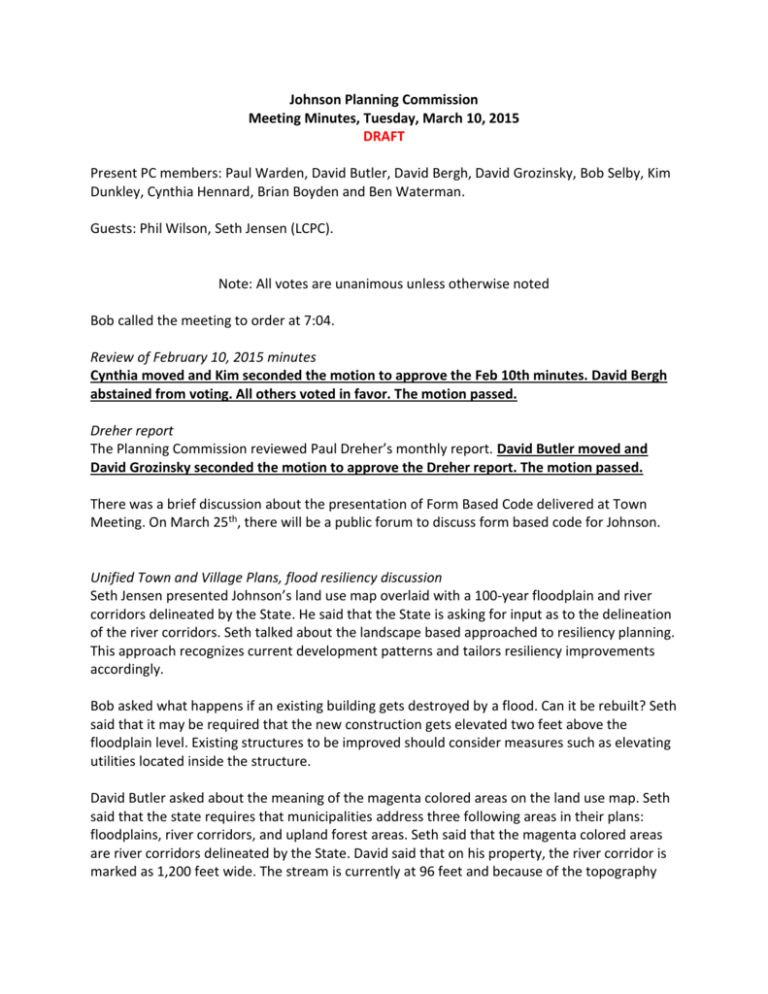
Johnson Planning Commission Meeting Minutes, Tuesday, March 10, 2015 DRAFT Present PC members: Paul Warden, David Butler, David Bergh, David Grozinsky, Bob Selby, Kim Dunkley, Cynthia Hennard, Brian Boyden and Ben Waterman. Guests: Phil Wilson, Seth Jensen (LCPC). Note: All votes are unanimous unless otherwise noted Bob called the meeting to order at 7:04. Review of February 10, 2015 minutes Cynthia moved and Kim seconded the motion to approve the Feb 10th minutes. David Bergh abstained from voting. All others voted in favor. The motion passed. Dreher report The Planning Commission reviewed Paul Dreher’s monthly report. David Butler moved and David Grozinsky seconded the motion to approve the Dreher report. The motion passed. There was a brief discussion about the presentation of Form Based Code delivered at Town Meeting. On March 25th, there will be a public forum to discuss form based code for Johnson. Unified Town and Village Plans, flood resiliency discussion Seth Jensen presented Johnson’s land use map overlaid with a 100-year floodplain and river corridors delineated by the State. He said that the State is asking for input as to the delineation of the river corridors. Seth talked about the landscape based approached to resiliency planning. This approach recognizes current development patterns and tailors resiliency improvements accordingly. Bob asked what happens if an existing building gets destroyed by a flood. Can it be rebuilt? Seth said that it may be required that the new construction gets elevated two feet above the floodplain level. Existing structures to be improved should consider measures such as elevating utilities located inside the structure. David Butler asked about the meaning of the magenta colored areas on the land use map. Seth said that the state requires that municipalities address three following areas in their plans: floodplains, river corridors, and upland forest areas. Seth said that the magenta colored areas are river corridors delineated by the State. David said that on his property, the river corridor is marked as 1,200 feet wide. The stream is currently at 96 feet and because of the topography (steep, ledgy terrain) the stream will not be able to spread as wide as the State outlined on the map. David also wanted to know how the river corridor maps may affect another one of his properties. This property was surveyed and permitted for construction. All permitted house sites will be two feet above the floodplain. However, since the property is marked as a river corridor, will that affect the marketability of the lots? Seth said that the State has developed a procedure for development within river corridors. This procedure does, in certain areas, create allowances for infill development. The State procedure for defining the infill development is not very clear and one thing that municipalities can do is to make the procedure more specific by defining where they would like the infill happen. Seth said that it was also important to identify areas where flood waters can spread. Ideally, these areas would be in places located upstream from the densely developed village center. There are non-regulatory tools, such as conservation easements, which are designed to motivate landowners to conserve their land from development and thus allowing the flood waters to dissipate into the floodplains. In the municipal plan, the Planning Commission can describe what they would like to see in areas upstream and downstream from the Village. Cynthia asked Seth to walk the Planning Commission through the draft of the flood resiliency document Seth wrote. Seth said that the document starts by introducing the landscape based approach to improving resiliency. The first page describes the existing settlement, particularly in Johnson Village. It says that the new development should be elevated two feet above based flood elevation. It also talks about creating compensatory storage for flood waters. In our community, an example could be the lowering of the parking lot at the Sterling Market Plaza. The next paragraph talks about the existing structures and outlines what can be done to reduce the damage from flooding to these structures. David asked how much more expensive it would be to remodel following the new guidelines. Seth said that FEMA has recently created more opportunities that can help finance the remodeling. Another option could be to create a revolving loan fund that would provide low interest loans to property owners to restore their properties after a flood. The next section of the draft describes improvements that Johnson already took to address flooding issues such as improvements at the sewer plant. It also talks about challenges associated with having utility facilities located in flood prone areas. Next, the draft defines “safer areas” as higher ground areas that may be suitable for development because they are close to the village center. We should discuss if we can identify such areas and include them into our plan. The draft of the flood resiliency document also contains a section that identifies undersized culverts and bridges. In Johnson, the River Corridor Management plan mentions two state owned bridges and one town bridge that are considered inadequate. To get a higher priority for state bridge replacement, it would be important to mention these state bridges in the municipal plan. The town owned bridge (Scribner Bridge) should also be mentioned in that it is a structure of historic importance. The River Corridor Management Plan recommends a complete removal of this bridge. Briand Boyden and Ben Waterman arrived at 8:30. Election of Planning Commission Chair David Bergh moved and David Grozinsky seconded the motion to nominate David Butler as Planning Commission Chair and Kim Dunkley as Vice-Chair. All voted in favor. Phil Wilson interview for Planning Commission membership Phil introduced himself. He said that he lives in town and his professional focus is on working with farmers on wetlands and stream alterations. He is employed by USDA’s Natural Resources Conservation Service. He has a degree in geography and took classes in planning. Bob Selby said that Phil was ideally suited for membership on the Planning Commission. Bob Selby’s resignation from Planning Commission On behalf of the Planning Commission, David Grozinsky and David Bergh recognized Bob Selby for his years of service on the Planning Commission and for leading the Planning Commission for the past few years. Meeting adjourned at 8:49 p.m. --Minutes taken by Lea Kilvadyova

